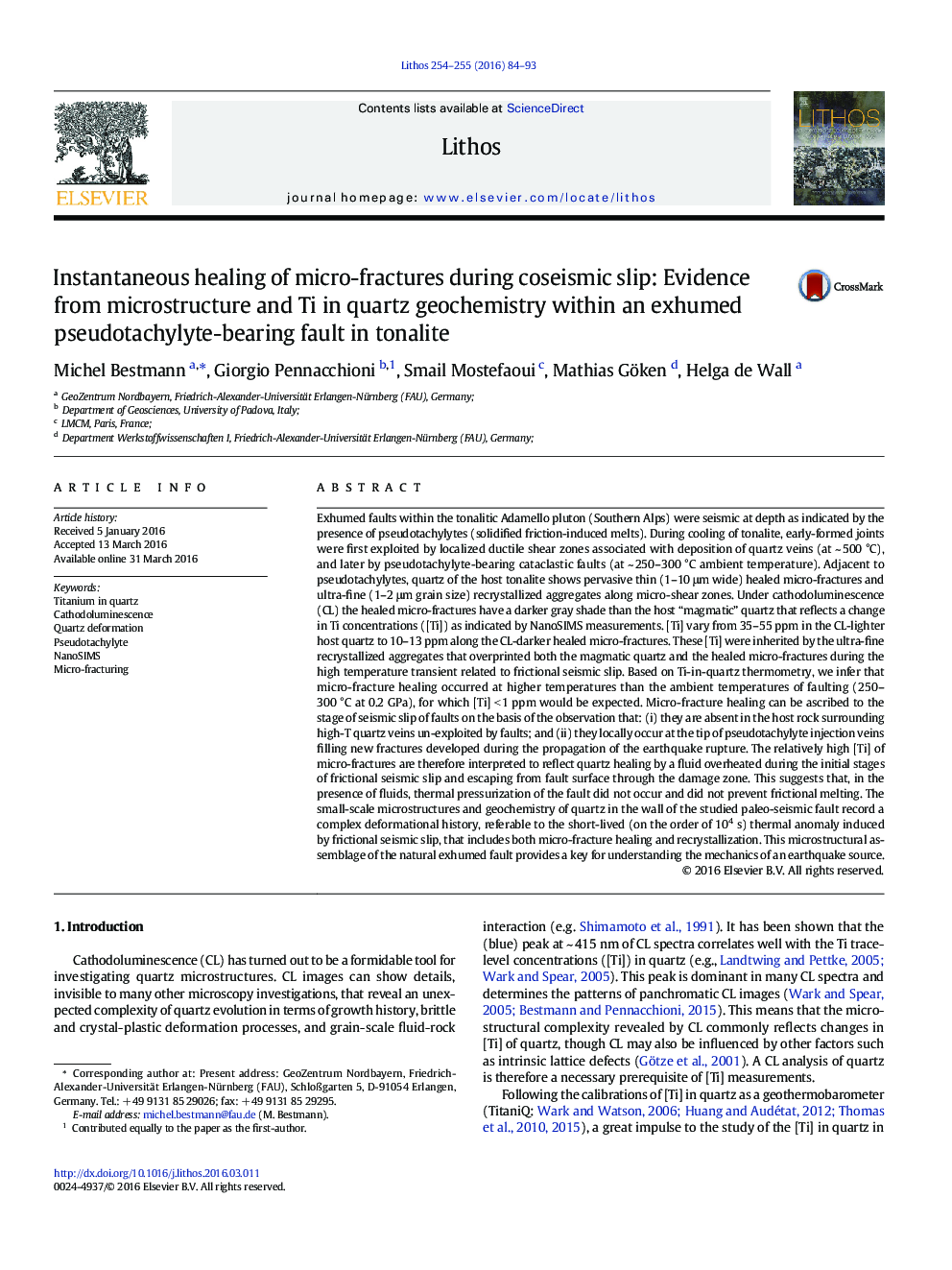| کد مقاله | کد نشریه | سال انتشار | مقاله انگلیسی | نسخه تمام متن |
|---|---|---|---|---|
| 4715513 | 1638647 | 2016 | 10 صفحه PDF | دانلود رایگان |

• Ti in quartz was measured by NanoSIMS in a tonalite adjacent to pseudotachylyte.
• Tonalite quartz contains healed micro-fractures evident in cathodoluminescence.
• Ti concentration [Ti] is 35–55 ppm in host quartz and 10–13 ppm in micro-fractures.
• TitaniQ indicates higher T during quartz healing than the ambient T of faulting.
• Micro-fracture healing occurred during seismic slip by frictionally heated fluids.
Exhumed faults within the tonalitic Adamello pluton (Southern Alps) were seismic at depth as indicated by the presence of pseudotachylytes (solidified friction-induced melts). During cooling of tonalite, early-formed joints were first exploited by localized ductile shear zones associated with deposition of quartz veins (at ~ 500 °C), and later by pseudotachylyte-bearing cataclastic faults (at ~ 250–300 °C ambient temperature). Adjacent to pseudotachylytes, quartz of the host tonalite shows pervasive thin (1–10 μm wide) healed micro-fractures and ultra-fine (1–2 μm grain size) recrystallized aggregates along micro-shear zones. Under cathodoluminescence (CL) the healed micro-fractures have a darker gray shade than the host “magmatic” quartz that reflects a change in Ti concentrations ([Ti]) as indicated by NanoSIMS measurements. [Ti] vary from 35–55 ppm in the CL-lighter host quartz to 10–13 ppm along the CL-darker healed micro-fractures. These [Ti] were inherited by the ultra-fine recrystallized aggregates that overprinted both the magmatic quartz and the healed micro-fractures during the high temperature transient related to frictional seismic slip. Based on Ti-in-quartz thermometry, we infer that micro-fracture healing occurred at higher temperatures than the ambient temperatures of faulting (250–300 °C at 0.2 GPa), for which [Ti] < 1 ppm would be expected. Micro-fracture healing can be ascribed to the stage of seismic slip of faults on the basis of the observation that: (i) they are absent in the host rock surrounding high-T quartz veins un-exploited by faults; and (ii) they locally occur at the tip of pseudotachylyte injection veins filling new fractures developed during the propagation of the earthquake rupture. The relatively high [Ti] of micro-fractures are therefore interpreted to reflect quartz healing by a fluid overheated during the initial stages of frictional seismic slip and escaping from fault surface through the damage zone. This suggests that, in the presence of fluids, thermal pressurization of the fault did not occur and did not prevent frictional melting. The small-scale microstructures and geochemistry of quartz in the wall of the studied paleo-seismic fault record a complex deformational history, referable to the short-lived (on the order of 104 s) thermal anomaly induced by frictional seismic slip, that includes both micro-fracture healing and recrystallization. This microstructural assemblage of the natural exhumed fault provides a key for understanding the mechanics of an earthquake source.
Figure optionsDownload as PowerPoint slide
Journal: Lithos - Volumes 254–255, June 2016, Pages 84–93